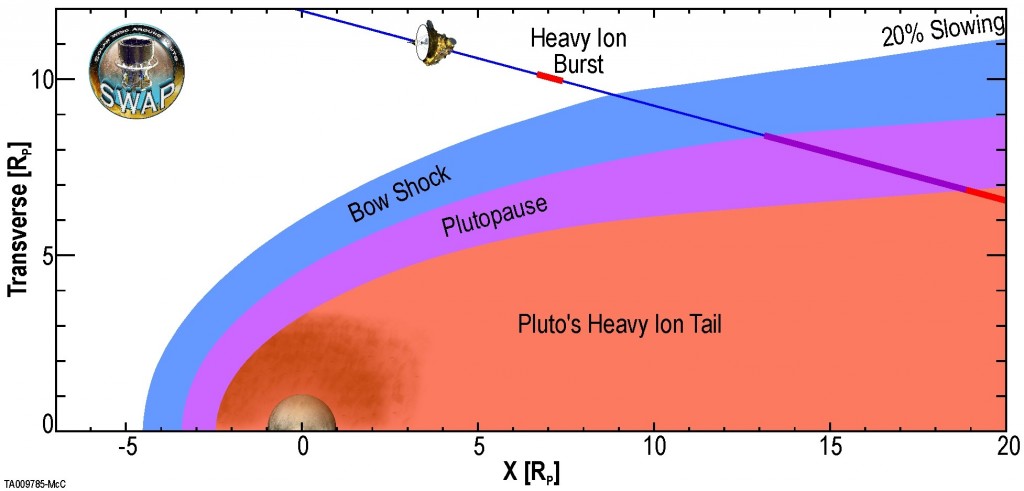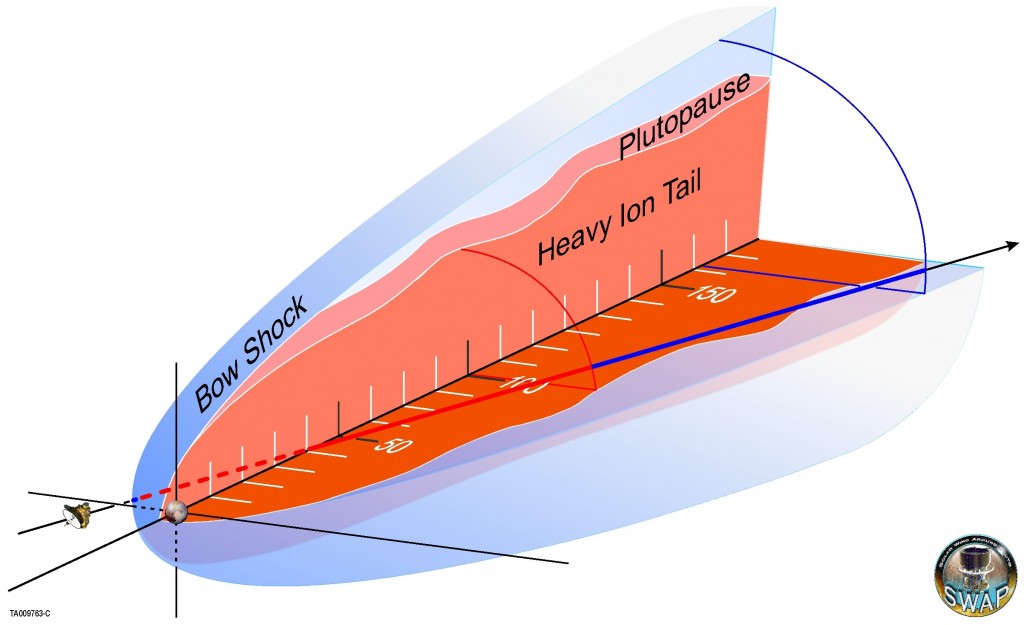4 May 2016
WASHINGTON, DC — Pluto has some characteristics less like that of a comet and more like much larger planets, according to an analysis of Pluto’s unique interaction with the solar wind, scientists say.
Using data from an instrument aboard the New Horizons spacecraft gathered on its Pluto flyby in July 2015, scientists have observed the material coming off of Pluto and seen how it interacts with the solar wind, and found it completely new – and unexpected.
“This is a type of interaction we’ve never seen before anywhere in our solar system,” said David J. McComas, lead author of the new study published today in the Journal of Geophysical Research – Space Physics, a publication of the American Geophysical Union.

Using data from an instrument aboard the New Horizons spacecraft gathered on its Pluto flyby in July 2015, scientists have observed the material coming off of Pluto and seen how it interacts with the solar wind. This figure shows the size scale of Pluto’s interaction with the solar wind derived from the data. The bow shock is indicated by the extension of the locations where the study’s authors measured the light, solar wind ions to be about 20 percent slowed down from the upstream solar wind speed. The Plutopause (purple) is a finite-sized boundary layer ~0.9 Pluto radii thick at the nose and separates the solar wind (blue) from the heavy ion tail (red). Even though the heavy ion tail extends back more than 100 Pluto radii at the time of the New Horizons flyby, the upstream interaction is very compact and the bow shock is almost compressed onto the obstacle.
Credit: American Geophysical Union.
McComas, professor in Princeton University’s Department of Astrophysical Sciences and vice president for the Princeton Plasma Physics Laboratory, leads the Solar Wind Around Pluto (SWAP) instrument aboard New Horizons; he also led development of SWAP when he was at the Southwest Research Institute (SwRI) in Texas. The research was funded as a part of the New Horizons project by NASA.
Space physicists say that they now have a treasure trove of information about how Pluto’s atmosphere interacts with the solar wind. Solar wind is the plasma, or charged particles, that spews off from the sun into the solar system at a supersonic 400 kilometers per second (1 million miles per hour), bathing planets, asteroids, comets and interplanetary space in a soup of mostly electrons and protons.
“The results are astonishing. We were fascinated and surprised” by the findings, McComas said.
Previously, most researchers thought that Pluto was characterized more like a comet, which has a large region of gentle slowing of the solar wind, as opposed to the abrupt diversion solar wind encounters at a planet like Mars or Venus. Instead, like a car that’s part gas- and part battery-powered, Pluto is a hybrid, the researchers say.
“This is an intermediate interaction, a completely new type. It’s not comet-like, and it’s not planet-like. It’s in-between,” McComas said. “We’ve now visited all nine of the classical planets and examined all their solar wind interactions, and we’ve never seen anything like this.”

Schematic diagram of Pluto’s interaction with the solar wind as inferred from SWAP observations along the trajectory of the New Horizons flyby. New Horizons crossed the Sun-Pluto line from the dawn/southern portion of the tail (dashed portion of trajectory) into the dusk/northern (solid portion of the trajectory in the cutaway) at ~44 Pluto radii down tail. Portions of the trajectory inside the heavy ion tail behind Pluto are indicated in red and light ion sheath that surrounds the tail are in blue. The bow shock observed near Pluto has dissipated into just a bow wave by the distance back that New Horizons exited through it.
Credit: American Geophysical Union.
“These results speak to the power of exploration. Once again we’ve gone to a new kind of place and found ourselves discovering entirely new kinds of expressions in nature,” said Alan Stern, New Horizons principal investigator at the Southwest Research Institute. “Many people were surprised by Pluto’s complex geology and atmosphere. This paper shows there’s even more that’s surprising there, including its atmosphere-solar wind interaction.”
Pluto continues to confound. Since it’s so far from the sun – an average of about 5.9 billion kilometers (3.7 billion miles) – and because it’s so small, scientists thought Pluto’s gravity would not be strong enough to hold heavy ions in its extended atmosphere. But, “Pluto’s gravity clearly is enough to keep material sufficiently confined,” McComas said.
Further, the scientists found that very little of Pluto’s atmosphere is comprised of neutral particles converted to electrically charged ions and swept out into space.
“This is backwards for many other planets, where the neutral particles stay relatively close to the planet,” said Michael Liemohn, a University of Michigan astrophysicist and Editor-in-Chief of JGR-Space Physics, who was not involved with the research but who helped edit the paper. “An ion particle becomes influenced by the electric and magnetic forces present in the solar system, which can be a very efficient acceleration processes. But at Pluto, McComas et al found that only a wisp of atmosphere leaves the planet as ions.”
The researchers were able to separate the heavy ions of methane, the main gas escaping from Pluto’s atmosphere, from the light ions of hydrogen that come from the sun using the SWAP instrument.
Among their Pluto findings:
- Like Earth, Pluto has a long ion tail, that extends downwind at least a distance of about 100 Pluto radii (119,000 kilometers (73,800 miles), almost three times the circumference of Earth), loaded with heavy ions from the atmosphere and with “considerable structure;”
- Pluto’s obstruction of the solar wind upwind of the planet is smaller than had been thought. The solar wind isn’t blocked until about the distance of a couple planetary radii (2,968 kilometers (1,844 miles), about the distance between Chicago and Los Angeles);
- Pluto has a very thin “Plutopause” – or boundary of Pluto’s tail of heavy ions and the sheath of the shocked solar wind that presents an obstacle to its flow.
The scientists write: “Pluto interaction with the solar wind appears to be a hybrid with the bow shock generated by mass-loading like at a comet, but the obstacle to the solar wind flow – the Plutopause – sustained by atmospheric thermal pressure as at Venus and Mars.”
Heather Elliott, astrophysicist at Southwest Research Institute and co-author on the paper, said that the study provides interesting comparisons. “Comparing the solar wind-Pluto interaction to the solar wind-interaction for other planets and bodies is interesting because the physical conditions are different for each, and the dominant physical processes depend on those conditions,” Elliott said.
What is significant, McComas said, is the range of diversity that bodies in the solar system have with the solar wind. Further, the findings offer clues to the magnetized plasmas that one might find around other stars. “The range of interaction with the solar wind is quite diverse, and this gives some comparison to help us better understand the connections in and beyond our solar system,” McComas said.
The scientists conclude: “The SWAP data will … be reanalyzed … for many years to come as the community collectively grapples with Pluto’s unique solar wind interaction – one that is unlike that at any other body in the solar system.”
New Horizons is the first mission in NASA’s New Frontiers program, managed by the agency’s Marshall Space Flight Center in Huntsville, Ala. The Johns Hopkins University Applied Physics Laboratory designed, built, and operates the New Horizons spacecraft and manages the mission under Principal Investigator Dr. Alan Stern’s direction for NASA’s Science Mission Directorate. SwRI leads the science mission, payload operations, and encounter science planning. The NASA Heliophysics program also supported the analysis of these observations.
###
The American Geophysical Union is dedicated to advancing the Earth and space sciences for the benefit of humanity through its scholarly publications, conferences, and outreach programs. AGU is a not-for-profit, professional, scientific organization representing more than 60,000 members in 139 countries. Join the conversation on Facebook, Twitter, YouTube, and our other social media channels.
Notes for Journalists
Journalists and public information officers (PIOs) of educational and scientific institutions who have registered with AGU can download a PDF copy of the article by clicking on this link: http://onlinelibrary.wiley.com/doi/10.1002/2016JA022599/abstract
Or, you may order a copy of the final paper by emailing a request to Lauren Lipuma at [email protected].
Please provide your name, the name of your publication, and your phone number.
Neither the paper nor this press release is under embargo.
“Pluto’s Interaction with the Solar Wind”
Authors:
D.J. McComas: Princeton University, Princeton, NJ, USA; Southwest Research Institute, San Antonio, TX, USA; and University of Texas at San Antonio, San Antonio, TX, USA;
H.A. Elliott: Southwest Research Institute, San Antonio, TX, USA;
Weidner and P. Valek: Southwest Research Institute, San Antonio, TX, USA; and University of Texas at San Antonio, San Antonio, TX, USA;
E.J. Zirnstein: Southwest Research Institute, San Antonio, TX, USA;
Bagenal: Laboratory of Atmospheric and Space Physics, Univ. of Colorado, Boulder, CO, USA;
P.A. Delamere: University of Alaska, Fairbanks, AK, USA;
R.W. Ebert: Southwest Research Institute, San Antonio, TX, USA;
H.O. Funsten: Los Alamos National Laboratory, Los Alamos, NM, USA;
Horanyi: Laboratory of Atmospheric and Space Physics, Univ. of Colorado, Boulder, CO, USA;
R.L. McNutt, Jr.: Johns Hopkins University Applied Physics Laboratory, Laurel, MD, USA;
Moser: Southwest Research Institute, San Antonio, TX, USA; and University of Texas at San Antonio, San Antonio, TX, USA;
N.A. Schwadron: University of New Hampshire, Durham, NH, USA;
D.F. Strobel: Johns Hopkins University, Baltimore, MD, USA;
L.A. Young: Southwest Research Institute, Boulder, CO, USA;
Ennico: NASA Ames Research Center, Space Science Division, Moffett Field, CA, USA;
B. Olkin: Southwest Research Institute, Boulder, CO, USA;
A. Stern: Southwest Research Institute, Boulder, CO, USA;
A. Weaver: Johns Hopkins University, Baltimore, MD, USA.
Contact Information for the Authors:
David McComas: +1 (210) 563 1905, [email protected]
Lauren Lipuma
+1 (202) 777-7396
[email protected]
Princeton University Contact:
Larry Bernard
+1 (609) 243-2755 (o), +1 (609) 480-1030 (c)
[email protected]